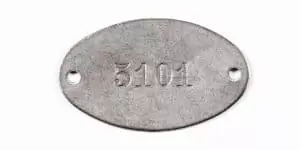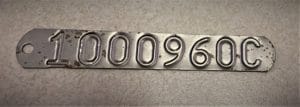Stamping and debossing are two processes which are result in a similar outcome: an indented design in a metal nameplate. Both marking methods are durable, and create a highly effective and legible identification solution.
While stamping and debossing are similar, there are a few key differences between these options.
Stamping
Durability
When it comes to durability, there are few processes which rival the resilience of stamping. There’s a reason why this marking method has been relied upon for so many years in industrial-type applications.
Since the design is pressed directly into the metal material itself, there is nothing to wear or fade.

Stamped nameplates are able to withstand all weather and the harshest working environments.
One major drawback to the stamping process is that since the design is indented, those indentations can become concealed if exposed to dirt, grime, or other substances.
Material
Most metal materials can be stamped with permanent information.
Selecting the right option is based on the specific application and environment it will be exposed to.
Some of the most common options include:
- Aluminum
- Stainless Steel
- Cold Rolled Steel
- Brass
Stamps
In order to indent characters into the metal substrate, a stamp must be used. For designs that range beyond basic numbers and letters, a custom stamp must be produced. This means that if you need 10 different designs, 10 different stamps need to be made.
When you start getting into custom stamps, the price of your metal nameplates may increase greatly to cover the additional production time and expense.

This is all dependent on quantity however. For example, one custom tag will be extremely expensive, while 10,000 will be much cheaper per piece.
If an organization wants a high quantity of custom nameplate with one design, stamp cost becomes less of a concern. Since only one stamp will be made, constant information is best suited for stamping.
Debossing
Debossing and stamping share many of the same characteristics, but with a few distinct differences as well.
Similarly to stamping, debossing presses a design down into a metal plate. However, this process uses a female-male die set to create characters which protrude outwards from the material.
Simply put, debossing is like an embossed design, but reversed.

If you aren’t familiar with embossing, think about the raise characters on a credit card. Now imagine them pressed downwards instead of raised from the surface. That’s debossing in a nutshell.
A quick way to tell the difference between stamping and debossing is to look at the back of the marked nameplate. If that side is flat (no markings) then it is most likely a stamped design. While if the back sports raised markings, it would be debossed.
Durability
Neither of these processes are slouches in the durability department. Just like embossing, debossed tags are extremely durable. Organizations typically see this type of marker last upwards of 20 years. Some see even longer lifespans.
Forming the metal material instead of using surface marking is a big difference. No printed inks means nothing to fade or wear away.
Material
Material options for these processes are typically pretty similar. Industrial organizations utilize the same metals whether stamping or debossing nameplates.
Anodized aluminum is a popular choice since it can be colorized for branding or color coding purposes.
Applications
Unlike stamping (and embossing), debossed tags are not typically used as a standard identification solution. Instead, they are most commonly used as a marking device. The protruding characters are used similarly to a stamp to mark the design in a material.
For example, tire manufacturers use this type of tag to embed a name or number into the rubber material of the tire as it is formed. This creates a lasting imprint, without requiring any additional labeling or printing.
Wrap Up
Both solutions are durable marking processes which create highly effective metal ID solutions. The indentations they make provide long-lasting information.
Debossing is similar to embossing in that the characters are raised on one side and recessed on the other. Stamping indents the front of the material, but leaves the tags flat on the back
The processes are suitable for use in a wide range of environments and applications. Their durability allows for use in tough industrial conditions, include exposure to the elements.
While debossing is a durable process, it does lose some of the benefits embossing provides, including the ability to clearly read the plate if covered in dirt or paint. Indented characters are harder to read in some of these situations.
At the end of the day, the best identification solution is the one that fits your application.